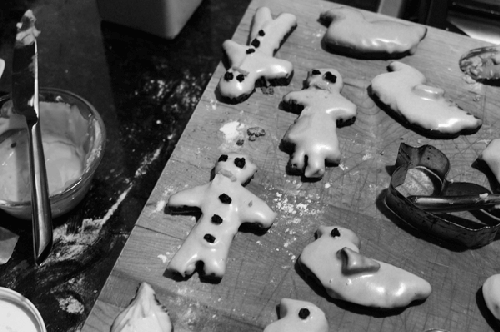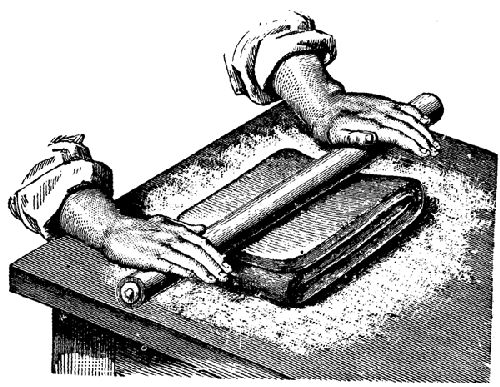Chemical leaveners aren’t always
used to create light, fluffy foods. Even dense items need some air to keep them
enjoyable.
In a bowl, mix together with a wooden spoon or electric beater:
½ cup (100g) sugar
6 tablespoons (80g) butter, softened but not
melted
½ cup (170g) molasses
1 tablespoon (17g) minced ginger (or ginger
paste)
In a separate bowl, whisk together:
3¼ cups (400g) flour
4 teaspoons (12g) ginger powder
1 teaspoon (5g) baking soda
2 teaspoons (3g) cinnamon
1 teaspoon (1g) allspice
½ teaspoon (2g) salt
½ teaspoon (2g) ground black pepper
Sift the dry ingredients into the bowl with the sugar/butter mixture. (I use a
strainer as a sifter.) Work the dry and wet ingredients together using a spoon or, if
you don’t mind, your hands. The dough will get to a crumbly, sand-like texture. Add ½
cup (120g) water and continue mixing until the dough forms a ball.
Turn out the dough onto a cutting board coated with a few tablespoons of flour.
Using a rolling pin, roll out the dough until it is about ¼″ (0.6 cm) thick. Cut it into
shapes using a cookie cutter or a paring knife and bake them on a cookie sheet in an
oven set to 400°F / 200°C until cooked, about eight minutes. The cookies should be
slightly puffed up and dry, but not overly dry.
Baking gingerbread cookies is, of course, a great holiday activity
with kids.

Gingerbread Cookie Frosting
In a microwave-safe bowl, mix together with a fork or electric beaters:
3 tablespoons (40g) butter, softened but not
melted
1 cup (200g) powdered sugar
1 tablespoon (15g) milk
1 teaspoon (4g) vanilla extract
Add food coloring if desired. Microwave the frosting for 15 to 30 seconds—long
enough to melt the frosting, but not so long that it boils. This will give you a
frosting that you can then quickly dip the cookies into and that will set into a nice,
thin coating that adheres well to the cookies.
